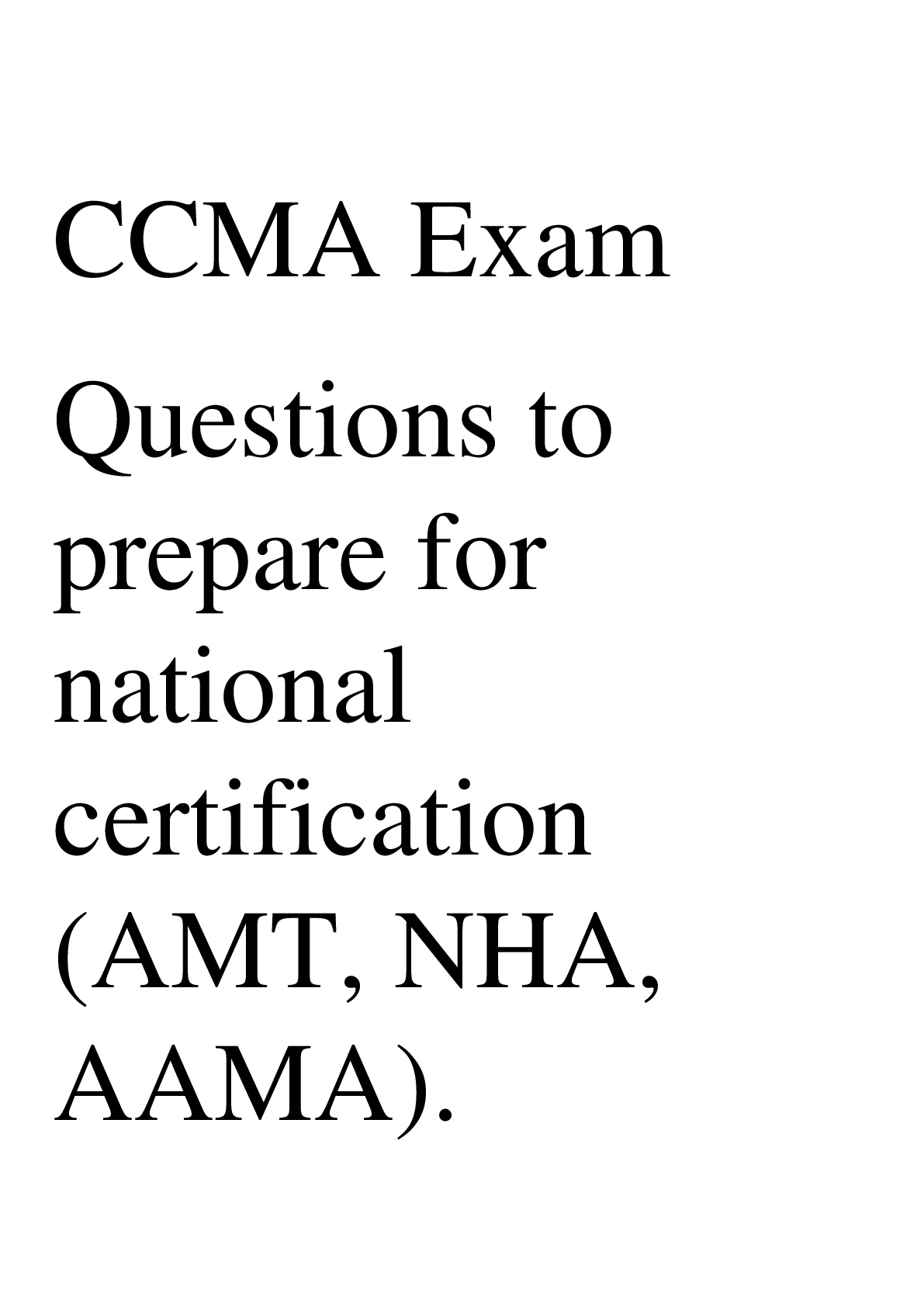*NURSING > Test Prep > Maternal Child Nursing Care 4th edition; Labor and Delivery questions & answers (Rationale) 2022-202 (All)
Maternal Child Nursing Care 4th edition; Labor and Delivery questions & answers (Rationale) 2022-2023.
Document Content and Description Below
Maternal Child Nursing Care 4th edition; Labor and Delivery questions & answers. The nurse has received a report about a woman in labor. The woman's last vaginal examination was recorded as 4, 80%, a... nd -2. The nurse's interpretation of this assessment is that: A) The cervix is dilated 4 cm, it is effaced 80%, and the presenting part is 2 cm below the ischial spines B) The cervix is effaced 4 cm, it is dilated 80%, and the presenting part is 2 cm below the ischial spines. C) The cervix is effaced 4 cm, it is dilated 80%, and the presenting part is 2 cm above the ischial spines D) The cervix is 4 cm dilated, it is effaced 80%, and the presenting part is 2 cm above the ischial spines What is the correct order of the cardinal movements? A.Extension B.Internal Rotation C.Expulsion D.Engagement, Flexion Descent E.External Rotation A) D, B, A, E, C B) D, A, B, E, C C) B, D, A, C, E D) D, B, A, C. E When assessing a woman in labor, the nurse is aware that the relationship of the fetal body parts to one another is called fetal: A) Lie. B) Position. C) Presentation. D) Attitude. To adequately care for a laboring woman, the nurse knows that which stage of labor varies the most in length? A) First B) Fourth C) Third D) Second Which position would the nurse suggest for second-stage labor if the pelvic outlet needs to be increased? A) Sitting B) Squatting C) Side-lying D) Semirecumbent When assessing the fetus using Leopold maneuvers, the nurse feels a round, hard, movable fetal part just above the symphysis and a long, smooth surface in the mother's left side close to midline. In the fundus, there is a prominence- when pushed the whole body seems to follow. What is the likely position of the fetus? A) RSA B) ROA C) LSP D) LOA With regard to fetal positioning during labor, nurses should be aware that: A) Birth is imminent when the presenting part is at +4 to +5 cm, below the spine. B) Engagement is the term used to describe the beginning of labor. C) The largest transverse diameter of the presenting part is the suboccipitobregmatic diameter. D) Position is a measure of the degree of descent of the presenting part of the fetus through the birth canal. Which presentation is described accurately in terms of both presenting part and frequency of occurrence? A) Cephalic: occiput; at least 95% B) Cephalic: cranial; 80% to 85% C) Shoulder: scapula; 10% to 15% D) Breech: sacrum; 10% to 15% A client is admitted to the labor and delivery unit with contractions that are 3-5 minutes apart, lasting 60-70 seconds. She reports that she is leaking fluid. A vaginal exam reveals that her cervix is 80 percent effaced and 4 cm dilated and a -1 station. The nurse knows that the client is in which phase and stage of labor? A) Latent phase, First Stage B) Active Phase of First Stage C) Latent phase of Second Stage D) Transition To assess uterine contractions the nurse would A) Asses duration from the beginning of the contraction to the peak of the same contraction, frequency by measuring the time between the beginning of one contraction to the beginning of the next contraction. B) Assess frequency as the time between the end of one contraction and the beginning of the next contraction, duration as the length of time from the beginning to the end of contractions, and palpate the uterus for strength C) Assess duration from beginning to end of each contraction. Assess the strength of the contraction by the external fetal monitor reading. Measure frequency by measuring the beginning of one contraction to another. D) Assess duration from beginning to end of each contraction., frequency by measuring the time between the beginnings of contractions, and palpate the fundus of the uterus for strength. Which basic type of pelvis includes the correct description and percentage of occurrence in women? A) Platypelloid: flattened, wide, shallow; 3% B) Anthropoid: resembling the ape; narrower; 10% C) Android: resembling the male; wider oval; 15% D) Gynecoid: classic female; heart shaped; 75% What position would be least effective when gravity is desired to assist in fetal descent? A) Lithotomy B) Walking C) Kneeling D) Sitting The factors that affect the process of labor and birth, known commonly as the five Ps, include all EXCEPT: A) Passageway. B) Powers. C) Passenger. D) Pressure. While evaluating an external monitor tracing of a woman in active labor, the nurse notes that the fetal heart rate (FHR) for five sequential contractions begins to decelerate late in the contraction, with the nadir of the decelerations occurring after the peak of the contraction. The nurse's first priority is to: A) Notify the care provider. B) Assist with amnioinfusion C) Change the woman's position D) Insert a scalp electrode. During labor a fetus with an average heart rate of 175 beats/min over a 15-minute period would be considered to have: A) A normal baseline heart rate. B) Bradycardia. C) Hypoxia. D) Tachycardia. As a perinatal nurse you realize that a fetal heart rate that is tachycardic, is bradycardic, or has late decelerations with loss of variability is nonreassuring and is associated with A) Cord compression B) Hypotension C) Hypoxemia/acidemia D) Maternal drug use. The nurse providing care for the laboring woman should understand that amnioinfusion is used to treat: A) Fetal tachycardia. B) Fetal bradycardia. C) Variable decelerations D) Late decelerations. The most common cause of decreased variability in the fetal heart rate (FHR) that lasts 30 minutes or less is: A) Fetal hypoxemia B) Fetal sleep cycles C) Altered cerebral blood flow. D) Umbilical cord compression. While evaluating an external monitor tracing of a woman in active labor whose labor is being induced, the nurse notes that the fetal heart rate (FHR) begins to decelerate in a slow curve at the onset of several contractions and returns to baseline before each contraction ends. The nurse should: A) Insert an internal monitor B) Document the finding in the client's record. C) Discontinue the oxytocin infusion D) Change the woman's position What three measures should the nurse implement to provide intrauterine resuscitation? Select the response that best indicates the priority of actions that should be taken. A) Reposition the mother, increase intravenous (IV) fluid, and provide oxygen via face mask. B) Perform a vaginal examination, reposition the mother, and provide oxygen via face mask. C) Administer oxygen to the mother, increase IV fluid, and notify the care provider. D) Call the provider, reposition the mother, and perform a vaginal examination When using intermittent auscultation (IA) to assess uterine activity, nurses should be aware that: A) The resting tone between contractions is described as either placid or turbulent B) The examiner's hand should be placed over the fundus before, during, and after contractions. C) The frequency and duration of contractions is measured in seconds for consistency D) Contraction intensity is given a judgment number of 1 to 7 by the nurse and client together. Perinatal nurses are legally responsible for: A) Applying the external fetal monitor and notifying the care provider. B) Correctly interpreting fetal heart rate (FHR) patterns, initiating appropriate nursing interventions, and documenting the outcomes. C) Greeting the client on arrival, assessing her, and starting an intravenous line. D) Making sure that the woman is comfortable. The nurse providing care for the laboring woman should understand that late fetal heart rate (FHR) decelerations are caused by: A) Altered cerebral blood flow B) Spontaneous rupture of membranes C) Uteroplacental insufficiency D) Umbilical cord compression The nurse providing care for the laboring woman should understand that variable fetal heart rate (FHR) decelerations are caused by: A) Umbilical cord compression. B) Altered fetal cerebral blood flow C) Fetal hypoxemia. D) Uteroplacental insufficiency Which of the following is NOT a reassuring component of the fetal heart rate A) FHR of 114 B) Accelerations of the FHR C) Moderate Variability D) Absent FHR Variability You are evaluating the fetal monitor tracing of your client, who is in active labor. Suddenly you see the fetal heart rate (FHR) drop from its baseline of 125 down to 80. You reposition the mother, provide oxygen, increase intravenous (IV) fluid, and perform a vaginal examination. The cervix has not changed. Five minutes have passed, and the fetal heart rate remains in the 80s. What additional nursing measures should you take? A) Call for help and Notify the care provider immediately B) Start pitocin C) Have her empty her bladder D) Insert a Foley catheter What is an advantage of external electronic fetal monitoring? A) Once correctly applied by the nurse, the transducer need not be repositioned even when the woman changes positions. B) The tocotransducer can measure and record the frequency, regularity, intensity, and approximate duration of uterine contractions (UCs). C) The external EFM does not require rupture of membranes or introduction of scalp electrode or IUPC which may introduce risk of infection or fetal scarring. D) The external EFM can accurately record FHR all the time. A number of methods to assist in the assessment of fetal well-being have been developed for use in conjunction with electronic fetal monitoring. These various technologies assist in supporting interventions for a nonreassuring fetal heart rate pattern when necessary. The labor and delivery nurse should be aware that one of these modalities, fetal oxygen saturation monitoring, includes the use of: A) Fetal blood sampling B) Umbilical cord acid-base determination C) Fetal pulse oximetry. D) A fetal acoustic stimulator. The nurse caring for the woman in labor should understand that maternal hypotension can result in: A) Uteroplacental insufficiency. B) Spontaneous rupture of membranes C) Fetal dysrhythmias. D) Early decelerations. The nurse providing care for the laboring woman should understand that accelerations with fetal movement: A) Are caused by umbilical cord compression B) Are caused by uteroplacental insufficiency C) Warrant close observation D) Are reassuring. A woman in active labor receives an analgesic, an opioid agonist. Which medication relieves severe, persistent, or recurrent pain; creates a sense of well-being; overcomes inhibitory factors; and may even relax the cervix but should be used cautiously in women with cardiac disease? A) Meperidine (Demerol) B) Promethazine (Phenergan) C) Butorphanol tartrate (Stadol) D) Nalbuphine (Nubain) A laboring woman received meperidine (Demerol) intravenously 90 minutes before she gave birth. Which medication should be available to reduce the postnatal effects of Demerol on the neonate? A) Fentanyl (Sublimaze) B) Promethazine (Phenergan) C) Naloxone (Narcan) D) Nalbuphine (Nubain) A woman in labor has just received an epidural block. The most important nursing intervention is to: A) Limit parenteral fluids. B) Monitor the fetus for possible tachycardia C) Monitor the maternal blood pressure for possible hypotension. D) Monitor the maternal pulse for possible bradycardia A woman is experiencing back labor and complains of intense pain in her lower back. An effective relief measure would be to use: A) Counterpressure against the sacrum B) Pant-blow (breaths and puffs) breathing techniques C) Effleurage. D) Conscious relaxation or guided imagery. A woman has requested an epidural for her pain. She is 5 cm dilated and 100% effaced. The baby is in a vertex position and is engaged. The nurse increases the woman's intravenous fluid for a preprocedural bolus. She reviews her laboratory values and notes that the woman's hemoglobin is 12 g/dl, hematocrit is 38%, platelets are 67,000, and white blood cells (WBCs) are 12,000/mm3. Which factor would contraindicate an epidural for the woman? A) She is too far dilated B) She is anemic. C) She has thrombocytopenia D) She is septic The role of the nurse with regard to informed consent is to: A) Inform the client about the procedure and have her sign the consent form. B) Act as a client advocate and help clarify the procedure and the options. C) Call the physician to see the client D) Witness the signing of the consent form. With regard to systemic analgesics administered during labor, nurses should be aware that: A) Systemic analgesics cross the maternal blood-brain barrier as easily as they do the fetal blood-brain barrier. B) Effects on the fetus and newborn can include decreased alertness and delayed sucking. C) Intramuscular administration (IM) is preferred over intravenous (IV) administration. D) IV patient-controlled analgesia (PCA) results in increased use of an analgesic. With regard to spinal and epidural (block) anesthesia, nurses should know that: A) This type of anesthesia is commonly used for cesarean births but is not suitable for vaginal births B) The incidence of after-birth headache is higher with spinal blocks than epidurals. C) Epidural blocks allow the woman to move freely D) Spinal and epidural blocks are never used together. Maternal hypotension is a potential side effect of regional anesthesia and analgesia. What nursing interventions could you use to raise the client's blood pressure? Choose all that apply. A) Place the woman in a supine position. B) Place the woman in a lateral position. C) Increase intravenous (IV) fluids. D) Continuous Fetal Monitor E) Administer ephedrine per MD order Nursing care measures are commonly offered to women in labor. Which nursing measure reflects application of the gate-control theory? A) Massaging the woman's back B) Changing the woman's position C) Giving the prescribed medication D) Encouraging the woman to rest between contractions A woman in the active phase of the first stage of labor is using a shallow pattern of breathing, which is about twice the normal adult breathing rate. She starts to complain about feeling lightheaded and dizzy and states that her fingers are tingling. The nurse should: A) Notify the woman's physician. B) Tell the woman to "calm down" and slow the pace of her breathing. C) Administer oxygen via a mask or nasal cannula. D) Help her breathe into a paper bag With regard to a pregnant woman's anxiety and pain experience, nurses should be aware that: A) Even mild anxiety must be treated. B) Severe anxiety increases tension, which increases pain, which in turn increases fear and anxiety, and so on. C) Anxiety may increase the perception of pain, but it does not affect the mechanism of labor. D) Women who have had a painful labor will have learned from the experience and have less anxiety the second time because of increased familiarity. Maternity nurses often have to answer questions about the many, sometimes unusual ways people have tried to make the birthing experience more comfortable. For instance, nurses should be aware that: A) Music supplied by the support person has to be discouraged because it could disturb others or upset the hospital routine. B) Women in labor can benefit from sitting in a bathtub, but they must limit immersion to no longer than 15 minutes at a time. C) Effleurage is permissible, but counterpressure is almost always counterproductive. D) Electrodes attached to either side of the spine to provide mild-intensity electrical impulses facilitate the release of endorphins. Your patient is a nulliparous woman, requesting pain relief. You examine her and she is 8 cm. What is the best option for pain relief at this point? A) Demerol B) Spinal C) Epidural D) Stadol A primiparous woman is in the triage room being evaluated for labor. She has been having contractions for 2 days, has slept little and is feeling exhausted. On cervical exam she is 1.5 cm dilated, 50% effaced, -1 station - which is not changed from a day ago. Contractions are irregular, 30-40 secs long. Which of the following is the best option for her? A) Offer morphine IM, and a sedative to help her sleep. B) Admit her and give her an epidural. C) Tell her to go home, relax D) Give her a couple of seconal to help her sleep. Which of the following is NOT a reason to come to labor and birth. A) The patient is 39 weeks with second baby. She has been having contractions for 2 hours. Contractions are getting longer and stronger and closer together. B) The patients says she has noticed greenish fluid leaking from her vagina. She is 41.5 weeks pregnant and not having contractions. C) The patient is 40 weeks and has contractions that are 8-10 minutes apart, 30 seconds long and been that way for 8 hours. D) The patient has not felt the baby move for 8 hours, despite drinking cold fluids, and nudging the baby with her hand. What is an expected characteristic of amniotic fluid? A) Deep yellow color B) Pale, straw color with small white particles C) Acidic result on a Nitrazine test D) Absence of ferning The uterine contractions of a woman early in the active phase of labor are assessed by an internal uterine pressure catheter (IUPC). The nurse notes that the intrauterine pressure at the peak of the contraction ranges from 65 to 70 mm Hg and the resting tone range is 6 to 10 mm Hg. The uterine contractions occur every 3 to 4 minutes and last an average of 55 to 60 seconds. On the basis of this information, the nurse should: A) Notify the woman's primary health care provider immediately B) Prepare to administer an oxytocic to stimulate uterine activity C) Document the findings because they reflect the expected contraction pattern for the active phase of labor. D) Prepare the woman for the onset of the second stage of labor. A multiparous woman has been in labor for 8 hours. Her membranes have just ruptured. The nurse's initial response would be to: A) Prepare the woman for imminent birth B) Notify the woman's primary health care provider. C) Document the characteristics of the fluid. D) Assess the fetal heart rate and pattern. Through vaginal examination the nurse determines that a woman is 4 cm dilated, and the external fetal monitor shows uterine contractions every 3.5 to 4 minutes. The nurse would report this as: A) First stage, latent phase B) First stage, active phase C) First stage, transition phase D) Second stage, latent phase The nurse expects to administer an oxytocic (e.g., Pitocin, Methergine) to a woman after expulsion of her placenta to: A) Relieve pain. B) Stimulate uterine contraction C) Prevent infection D) Facilitate rest and relaxation. Vaginal examinations should be performed by the nurse under all of these circumstances EXCEPT: A) An admission to the hospital at the start of labor. B) When accelerations of the fetal heart rate (FHR) are noted. C) On maternal perception of perineal pressure or the urge to bear down. D) When membranes rupture. With regard to a woman's intake and output during labor, nurses should be aware that: A) The tradition of restricting the laboring woman to clear liquids and ice chips is being challenged because regional anesthesia is used more often than general anesthesia and studies are not showing harm from drinking fluids in labor. B) Intravenous (IV) fluids usually are necessary to ensure that the laboring woman stays hydrated. C) Routine use of an enema empties the rectum and is very helpful for producing a clean, clear delivery. D) When a nulliparous woman experiences the urge to defecate, it often means birth will follow quickly For women who have a history of sexual abuse, a number of traumatic memories may be triggered during labor. The woman may fight the labor process and react with pain or anger. Alternately she may become a passive player and emotionally absent herself from the process. The nurse is in a unique position of being able to assist the client to associate the sensations of labor with the process of childbirth and not the past abuse. The nurse can implement a number of care measures to help her client view the childbirth experience in a positive manner. Which intervention would be key for the nurse to use while providing care? A) Telling the client to relax and that it won't hurt much B) Limiting the number of procedures that invade her body C) Reassuring the client that as the nurse you know what is best D) Allowing unlimited care providers to be with the client Concerning the third stage of labor, nurses should be aware that: A) The placenta eventually detaches itself from a flaccid uterus B) An active approach to managing this stage of labor reduces the risk of excessive bleeding C) It is important that the dark, roughened maternal surface of the placenta appear before the shiny fetal surface. D) The major risk for women during the third stage is a rapid heart rate. When planning care for a laboring woman whose membranes have ruptured, the nurse recognizes that the woman's risk for _____ has increased. A) Intrauterine infection B) Hemorrhage C) Precipitous labor D) Supine hypotension When managing the care of a woman in the second stage of labor, the nurse uses various measures to enhance the progress of fetal descent. These measures include: A) Encouraging the woman to try various upright positions, including squatting and standing. Giving positive feedback about her efforts. B) Telling the woman to start pushing as soon as her cervix is fully dilated. C) Stopping the epidural anesthetic so the woman can feel the urge to push and thereby push more effectively D) Coaching the woman to use sustained, 10- to 15-second, closed-glottis bearing-down efforts with each contraction. When assessing a multiparous woman who has just given birth to an 8-pound boy, the nurse notes that the woman's fundus is firm and has become globular in shape. A gush of dark red blood comes from her vagina. The nurse concludes that: A) The placenta has separated. B) A cervical tear occurred during the birth C) The woman is beginning to hemorrhage. D) Clots have formed in the upper uterine segment. Nurses can help their clients by keeping them informed about the distinctive stages of labor. What description of the phases of the first stage of labor is accurate? A) Latent: Mild, regular contractions; no dilation; bloody show; duration of 2 to 4 hours B) Active: Moderate, regular contractions; 4- to 7-cm dilation; duration of 3 to 6 hours C) Lull: No contractions; dilation stable; duration of 20 to 60 minutes D) Transition: Very strong but irregular contractions; 8- to 10-cm dilation; duration of 3-4 hours Match the degree of tear or episiotomy to its description A. Laceration that goes through the anal sphincter and the rectal wall B. a tear through part or all of the perineal muscles C. small nick in the perineum, not involving muscle D. Laceration through part or all of anal sphincter muscle 1st degree 2nd degree 3rd degree 4th degree Which of the following is true about placenta previa. A) The bleeding from placenta previa usually occurs late in pregnancy at term. B) In evaluating the bleeding, a vaginal exam would be done to determine the cause of the bleeding. C) Symptoms of placenta previa are painful frequent contractions and bright red vaginal bleeding D) Once placenta previa is diagnosed by a 20 week ultrasound, it is very likely the placenta previa will resolve in the third trimester. What assessment is least likely to be associated with a breech presentation? A) Fetal heart tones heard at or above the maternal umbilicus B) Meconium-stained amniotic fluid C) Postterm gestation D) Preterm labor and birth During labor, the patient at 4 cm suddenly becomes dyspneic, cyanotic, and hypotensive. The nurse must prepare immediately for: (Select all that apply.) A) Immediate vaginal delivery B) Cesarean delivery C) CPR D) McRobert's maneuver A pregnant woman's amniotic membranes rupture. Prolapsed cord is suspected. What intervention would be the top priority? A) Starting oxygen by face mask B) Preparing the woman for a cesarean birth C) Covering the cord in sterile gauze soaked in saline D) Placing the woman in the knee-chest position Which of the following is correct about care for a pregnant woman who has experienced blunt trauma in a car accident? (See Labor Complications Part 4 power point) A) Rhogam is not necessary for rH negative pregnant women after a blunt force trauma. B) If the woman does not have more than 6 ctx an hour she may go home after 4 hours. C) The two most common risks are preterm labor and fetal death. D) In the ER she is evaluated and treated to hemodynamically stabilize her, then she is evaluated with an electronic fetal monitor for a minimum of 4 hours. In evaluating the effectiveness of magnesium sulfate for the treatment of preterm labor, what finding would alert the nurse to possible side effects? A) Serum magnesium level of 10 mg/dl B) Respiratory rate of 16 breaths/min C) Deep tendon reflexes 2+ and no clonus D) Urine output of 160 ml in 4 hours For a woman at 42 weeks of gestation, which finding would require more assessment by the nurse? A) One fetal movement noted in 1 hour of assessment by the mother B) Fetal heart rate of 116 beats/min C) Cervix dilated 2 cm and 50% effaced D) Score of 8 on the biophysical profile Which of the following is true with respect to chorioamninitis? (See power point Labor Complications part 4) A) If a woman has chorioamnionitis she will be treated with penicilin and cefotetan. B) Most often chorioamnionitis is caused by pathogens such as GBBS, pneumococci, and CMV. C) Once a woman who has had chorioamnionitis has delivered the antibiotics will be stopped. D) An epidural can cause maternal fever and fetal tachycardia. The nurse recognizes that uterine hyperstimulation with oxytocin requires emergency interventions. What clinical cues would alert the nurse that the woman is experiencing uterine hyperstimulation? Choose all that apply. A) Uterine contractions lasting <90 seconds and occurring >2 minutes in frequency B) Uterine contractions lasting >90 seconds and occurring <2 minutes in frequency C) Uterine resting tone >20 mm Hg D) Uterine resting tone <20 mm Hg E) Increased uterine activity accompanied by a nonreassuring fetal heart rate (FHR) pattern A woman arrive in the admission area of L&D. She is complaining of severe abdominal pain which she thinks are contractions and vaginal bleeding. You notice the sheet on the bed is about 1/3 covered with port wine fluid. You would do all of the following EXCEPT: A) Take a complete medical history and measure her vital signs. B) Position on her side and give her oxygen if the fetal heart rate was category II. C) NOtify the charge nurse and patient's provider. D) Start an IV E) Put her on the monitor The nurse is caring for a client whose labor is being augmented with oxytocin. He or she recognizes that the oxytocin should be discontinued immediately if there is evidence of: A) Uterine contractions occurring every 8 to 10 minutes B) Rupture of the client's amniotic membranes. C) A fetal heart rate (FHR) of 180 with absence of variability. D) The client needing to void. With regard to the use of tocolytic therapy to suppress premature uterine activity, nurses should be aware that: A) Its most important function is to afford the opportunity to administer antenatal glucocorticoids. B) The drugs can be given efficaciously up to the designated beginning of term at 37 weeks. C) If the client develops pulmonary edema while on tocolytics, intravenous (IV) fluids should be given. D) There are no important maternal (as opposed to fetal) contraindications. With regard to the process of augmentation of labor, the nurse should be aware that it: A) Augmentation is the use of medications to start labor that has not begun yet. B) Relies on more invasive methods when oxytocin and amniotomy have failed. C) Is part of the active management of labor that is instituted when the labor process is unsatisfactory. D) Is a modern management term to cover up the negative connotations of forceps-assisted birth Choose ALL that are true about post dates pregnancy. A) All women should be induced within a few days past their due date. B) Additional tests of fetal well being are ordered after the due date and include a nonstress test, fetal movement counting, and biophysical profile or Amniotic fluid Index. C) A low amniotic fluid index of less than 8 is associated with a higher incidence of low Apgar scores of 7 or lower. D) Post dates pregnancy is associated with larger babies, prolonged labor, fetal distressi in labor, meconium aspiration syndrome and more cesarean births. A woman at 26 weeks of gestation is being assessed to determine whether she is experiencing preterm labor. What finding indicates that preterm labor is occurring? (Note: see power point on complications of Labor for homework part 1 on preterm labor) A) Estriol is not found in maternal saliva. B) Irregular, mild uterine contractions are occurring every 12 to 15 minutes C) Fetal fibronectin is present in vaginal secretions. D) The cervix is effacing and dilated to 2 cm. A woman in preterm labor at 30 weeks of gestation receives two 12-mg doses of betamethasone intramuscularly. The purpose of this pharmacologic treatment is to: A) Suppress uterine contractions. B) Maintain adequate maternal respiratory effort and ventilation during magnesium sulfate therapy. C) Stimulate fetal surfactant production. D) Reduce maternal and fetal tachycardia associated with ritodrine administration Prepidil (prostaglandin gel) has been ordered for a pregnant woman at 43 weeks of gestation. The nurse recognizes that this medication will be administered to: A) Increase amniotic fluid volume. B) Stimulate the amniotic membranes to rupture. C) Enhance uteroplacental perfusion in an aging placenta. D) Ripen the cervix in preparation for labor induction. Which of the following is true about labor dystocia. A) Labor dystocia would be defined if it took longer than an hour to dilate 1 cm during active labor in a first time laboring woman. B) In a nulliparous women with an arrest of labor, the use of pitocin will only help about 25% of women achieve a vaginal birth. C) second stage is abnormally long if it takes longer than 1 hour in a first time mother. D) When a woman has weak and infrequent contractions it is an indication that the baby is too large and she needs to have a Cesarean soon. In evaluating the effectiveness of oxytocin induction, the nurse would expect: A) Contractions lasting 40 to 90 seconds, 2 to 3 minutes apart. B) Labor to progress at least 2 cm/hr dilation. C) At least 30 mU/min of oxytocin will be needed to achieve cervical dilation D) The intensity of contractions to be at least 110 to 130 mm Hg. Select ALL that are true about post dates pregnancy. A) After the due date, women should have assessments of fetal well beings which could include fetal movement counting, biophysical profile and non stress test. B) All women should be induced within a few days part their due date. C) Risks associated with going past 42 weeks gestation include a large baby, low amniotic fluid, meconium aspiration syndrome, and fetal distress in labor. D) An amniotic fluid index of less than 8 has been associated with a higher incidence of Apgar scores less than 7 at 5 minutes. A) Preterm labor is defined as cervical changes and uterine contractions occurring between 20 and 37 weeks of pregnancy. B) In the United States early in this century, preterm birth accounted for 18% to 20% of all births. C) Low birth weight is anything below 3.7 pounds. D) The terms preterm birth and low birth weight can be used interchangeably. The nurse providing care for a woman with preterm labor on terbutaline would include which intervention to identify side effects of the drug? A) Assessing for dyspnea and crackles B) Assessing for bradycardia C) Assessing deep tendon reflexes (DTRs) D) Assessing for hypoglycemia A woman at 39 weeks of gestation with a history of preeclampsia is admitted to the labor and birth unit. She suddenly experiences increased contraction frequency of every 1 to 2 minutes; dark red vaginal bleeding; and a tense, painful abdomen. The nurse suspects the onset of: A) Placental abruption. B) Rupture of the uterus. C) Placenta previa. D) Eclamptic seizure. A pregnant woman has been receiving a magnesium sulfate infusion for treatment of severe preeclampsia for 24 hours. On assessment the nurse finds the following vital signs: temperature of 37.3° C, pulse rate of 88 beats/min, respiratory rate of 10 breaths/min, blood pressure (BP) of 148/90 mm Hg, absent deep tendon reflexes, and no ankle clonus. The client complains, "I'm so thirsty and warm." The nurse: A) Discontinues the magnesium sulfate infusion. B) Administers oxygen. C) Calls for a stat magnesium sulfate level. D) Prepares to administer hydralazine. The labor of a pregnant woman with preeclampsia is going to be induced. Before initiating the Pitocin infusion, the nurse reviews the woman's latest laboratory test findings, which reveal a platelet count of 90,000, an elevated aspartate transaminase (AST) level, and decreased serum haptoglobin. The nurse notifies the physician because the laboratory results are indicative of: A) Eclampsia. B) Idiopathic thrombocytopenia. C) Disseminated intravascular coagulation (DIC). D) HELLP syndrome. Your client has been on magnesium sulfate for 20 hours for treatment of preeclampsia. She just delivered a viable infant girl 30 minutes ago. What uterine findings would you expect to observe/assess in this client? A) Absence of uterine bleeding in the postpartum period B) A fundus firm below the level of the umbilicus C) Scant lochia flow D) A boggy uterus with heavy lochia flow A primigravida is being monitored in her prenatal clinic for preeclampsia. What finding should concern her nurse? A) A dipstick value of 3+ for protein in her urine B) Pitting pedal edema at the end of the day C) Blood pressure (BP) increase to 138/86 mm Hg D) Weight gain of 0.5 kg during the past 2 weeks A woman with preeclampsia has a seizure. The nurse's primary duty during the seizure is to: A) Stay with the client and call for help. B) Insert an oral airway. C) Administer oxygen by mask. D) Suction the mouth to prevent aspiration. Your client is being induced because of her worsening preeclampsia. She is also receiving magnesium sulfate. It appears that her labor has not become active despite several hours of oxytocin administration. She asks the nurse, "Why is it taking so long?" The most appropriate response by the nurse would be: A) "Your baby is just being stubborn." B) "The length of labor varies for different women." C) "The magnesium is relaxing your uterus and competing with the oxytocin. It may increase the duration of your labor." D) "I don't know why it is taking so long." A woman with severe preeclampsia has been receiving magnesium sulfate by intravenous infusion for 8 hours. The nurse assesses the woman and documents the following findings: temperature of 37.1° C, pulse rate of 96 beats/min, respiratory rate of 24 breaths/min, blood pressure (BP) of 175/112 mm Hg, 3+ deep tendon reflexes, and no ankle clonus. The nurse calls the physician, anticipating an order for: A) Hydralazine. B) Magnesium sulfate bolus. C) Diazepam. D) Calcium gluconate. Magnesium sulfate is given to women with preeclampsia and eclampsia to: A) Improve patellar reflexes and increase respiratory efficiency. B) Shorten the duration of labor. C) Prevent and treat convulsions. D) Prevent a boggy uterus and lessen lochial flow. The nurse is preparing to discharge a 30-year-old woman who has experienced a miscarriage at 10 weeks of gestation. Which statement by the woman would indicate a correct understanding of the discharge instructions? A) "I will not experience mood swings since I was only at 10 weeks of gestation." B) "I will avoid sexual intercourse for 6 weeks and pregnancy for 6 months." C) "I should eat foods that are high in iron and protein to help my body heal." D) "I should expect the bleeding to be heavy and bright red for at lease 1 week." The nurse is caring for a woman who is at 24 weeks of gestation with suspected severe preeclampsia. Which signs and symptoms would the nurse expect to observe? Select all that apply. A) Decreased urinary output and irritability B) Transient headache and +1 proteinuria C) Ankle clonus and epigastric pain D) Platelet count of less than 100,000/mm3 and visual problems E) Seizure activity and hypotension A primigravida asks the nurse about signs she can look for that would indicate that the onset of labor is getting closer. The nurse should describe: A. Weight gain of 1 to 3 pounds. B. Quickening. C. Fatigue and lethargy. D. Bloody show. The nurse should tell a primigravida that the definitive sign indicating that labor has begun would be: A. Progressive uterine contractions. B. Lightening. C. Rupture of membranes. D. Passage of the mucous plug (operculum). "ANS"- A. Progressive uterine contractions. On completion of a vaginal examination on a laboring woman, the nurse records: 50%, 6 cm, -1. What is a correct interpretation of the data? A. The fetal presenting part is 1 cm above the ischial spines. B. Effacement is 4 cm from completion. C. Dilation is 50% completed. D. The fetus has achieved passage through the ischial spines. A laboring woman becomes anxious during the transition phase of the first stage of labor and develops a rapid and deep respiratory pattern. She complains of feeling dizzy and light-headed. The nurse's immediate response would be to: A. Encourage the woman to breathe more slowly. B. Help the woman breathe into a paper bag. C. Turn the woman on her side. D. Administer a sedative. A woman is in the second stage of labor and has a spinal block in place for pain management. The nurse obtains the woman's blood pressure and notes that it is 20% lower than the baseline level. Which action should the nurse take? A. Encourage her to empty her bladder. B. Decrease her intravenous (IV) rate to a keep vein-open rate. C. Turn the woman to the left lateral position or place a pillow under her hip. D. No action is necessary since a decrease in the woman's blood pressure is expected. When assessing a fetal heart rate (FHR) tracing, the nurse notes a decrease in the baseline rate from 155 to 110. The rate of 110 persists for more than 10 minutes. The nurse could attribute this decrease in baseline to: A. Maternal hyperthyroidism. B. Initiation of epidural anesthesia that resulted in maternal hypotension. C. Maternal infection accompanied by fever. D. Alteration in maternal position from semirecumbent to lateral. On review of a fetal monitor tracing, the nurse notes that for several contractions the fetal heart rate decelerates as a contraction begins and returns to baseline just before it ends. The nurse should: A. Describe the finding in the nurse's notes. B. Reposition the woman onto her side. C. Call the physician for instructions. D. Administer oxygen at 8 to 10 L/min with a tight face mask. Which finding meets the criteria of a reassuring fetal heart rate (FHR) pattern? A. FHR does not change as a result of fetal activity. B. Average baseline rate ranges between 100 and 140 beats/min. C. Mild late deceleration patterns occur with some contractions. D. Variability averages between 6 to 10 beats/min. Late deceleration patterns are noted when assessing the monitor tracing of a woman whose labor is being induced with an infusion of Pitocin. The woman is in a side-lying position, and her vital signs are stable and fall within a normal range. Contractions are intense, last 90 seconds, and occur every 1½ to 2 minutes. The nurse's immediate action would be to: A. Change the woman's position. B. Stop the Pitocin. C. Elevate the woman's legs. D. Administer oxygen via a tight mask at 8 to 10 L/min. Which characteristic is associated with false labor contractions? A. Painless B. Decrease in intensity with ambulation C. Regular pattern of frequency established D. Progressive in terms of intensity and duration A pregnant couple has formulated a birth plan and is reviewing it with the nurse at an expectant parent's class. Which aspect of their birth plan would be considered unrealistic and require further discussion with the nurse? A. "My husband and I have agreed that my sister will be my coach since he becomes anxious with regard to medical procedures and blood. He will be nearby and check on me every so often to make sure everything is OK." B. "We plan to use the techniques taught in the Lamaze classes to reduce the pain experienced during labor." C. "We want the labor and birth to take place in a birthing room. My husband will come in the minute the baby is born." D. "We do not want the fetal monitor used during labor since it will interfere with movement and doing effleurage." When performing vaginal examinations on laboring women, the nurse should be guided by what principle? A. Cleanse the vulva and perineum before and after the examination as needed B. Wear a clean glove lubricated with tap water to reduce discomfort C. Perform the examination every hour during the active phase of the first stage of labor D. Perform immediately if active bleeding is present The nurse should realize that the most common and potentially harmful maternal complication of epidural anesthesia is: A. Severe postpartum headache. B. Limited perception of bladder fullness. C. Increase in respiratory rate. D. Hypotension. A laboring woman's amniotic membranes have just ruptured. The immediate action of the nurse would be to: A. Assess the fetal heart rate (FHR) pattern. B. Perform a vaginal examination. C. Inspect the characteristics of the fluid. D. Assess maternal temperature. A woman is evaluated to be using an effective bearing-down effort if she: A. Begins pushing as soon as she is told that her cervix is fully dilated and effaced. B. Takes two deep, cleansing breaths at the onset of a uterine contraction and at the end of the contraction. C. Uses the Valsalva maneuver by holding her breath and pushing vigorously for a count of 12. D. Continues to push for short periods between uterine contractions throughout the second stage of labor. Following rupture of membranes, a prolapse of the cord was noted on vaginal examination. A recommended action to prevent cord compression would be to: A. Place woman in a supine position and elevate legs from the hips. B. Insert a Foley catheter to keep the bladder empty. C. Keep the protruding cord moist with warm sterile normal saline compresses. D. Attempt to reinsert the cord. [Show More]
Last updated: 1 year ago
Preview 1 out of 24 pages
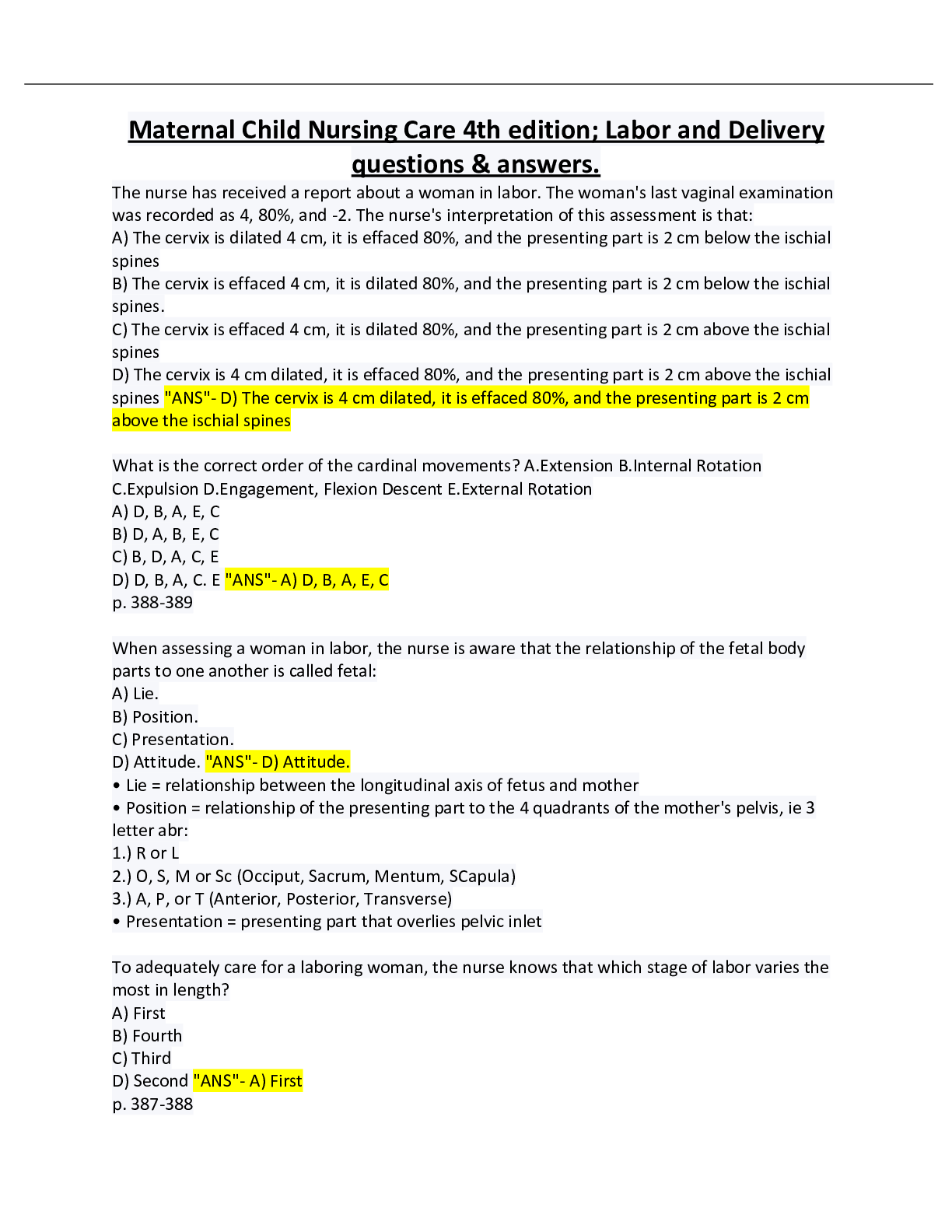
Reviews( 0 )
Document information
Connected school, study & course
About the document
Uploaded On
Oct 25, 2022
Number of pages
24
Written in
Additional information
This document has been written for:
Uploaded
Oct 25, 2022
Downloads
0
Views
97

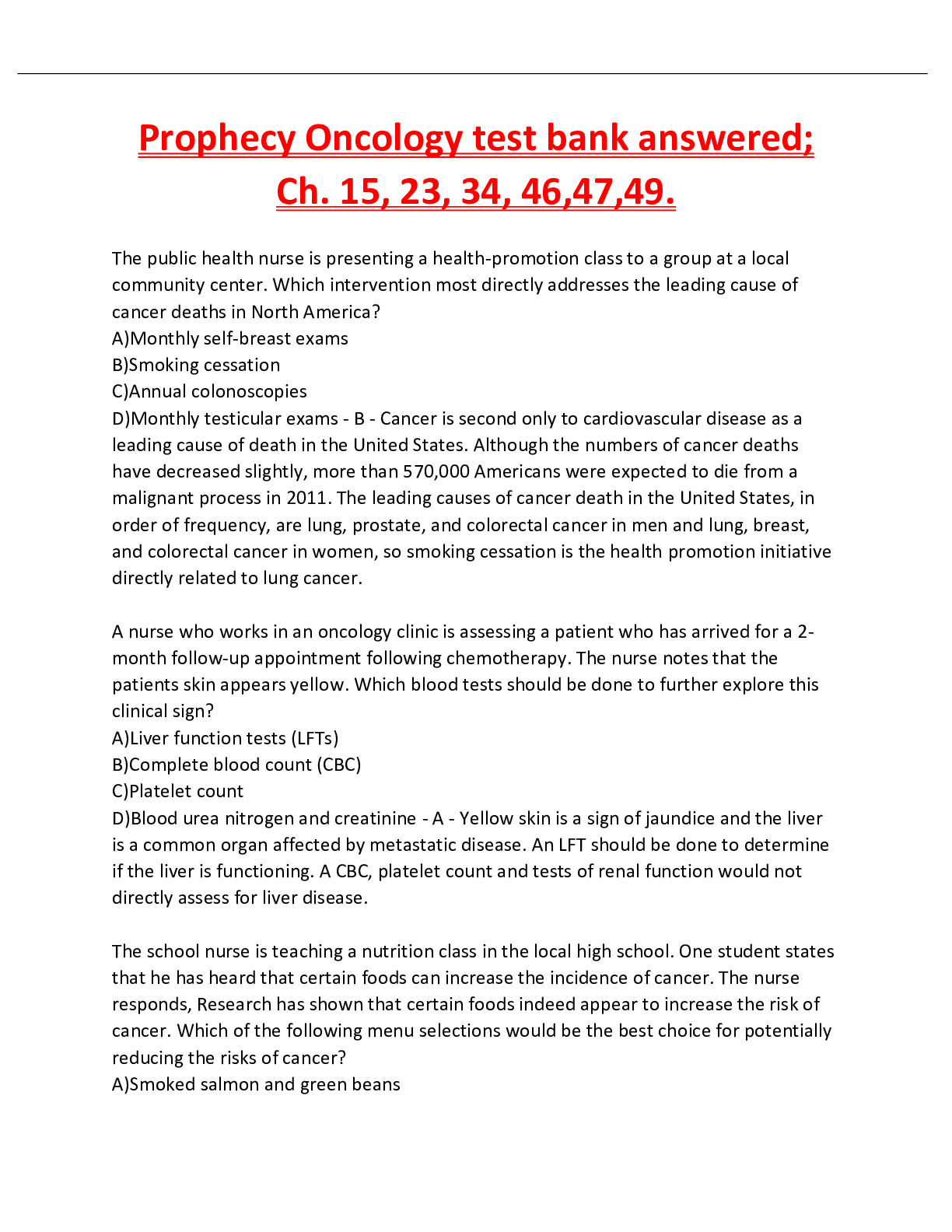
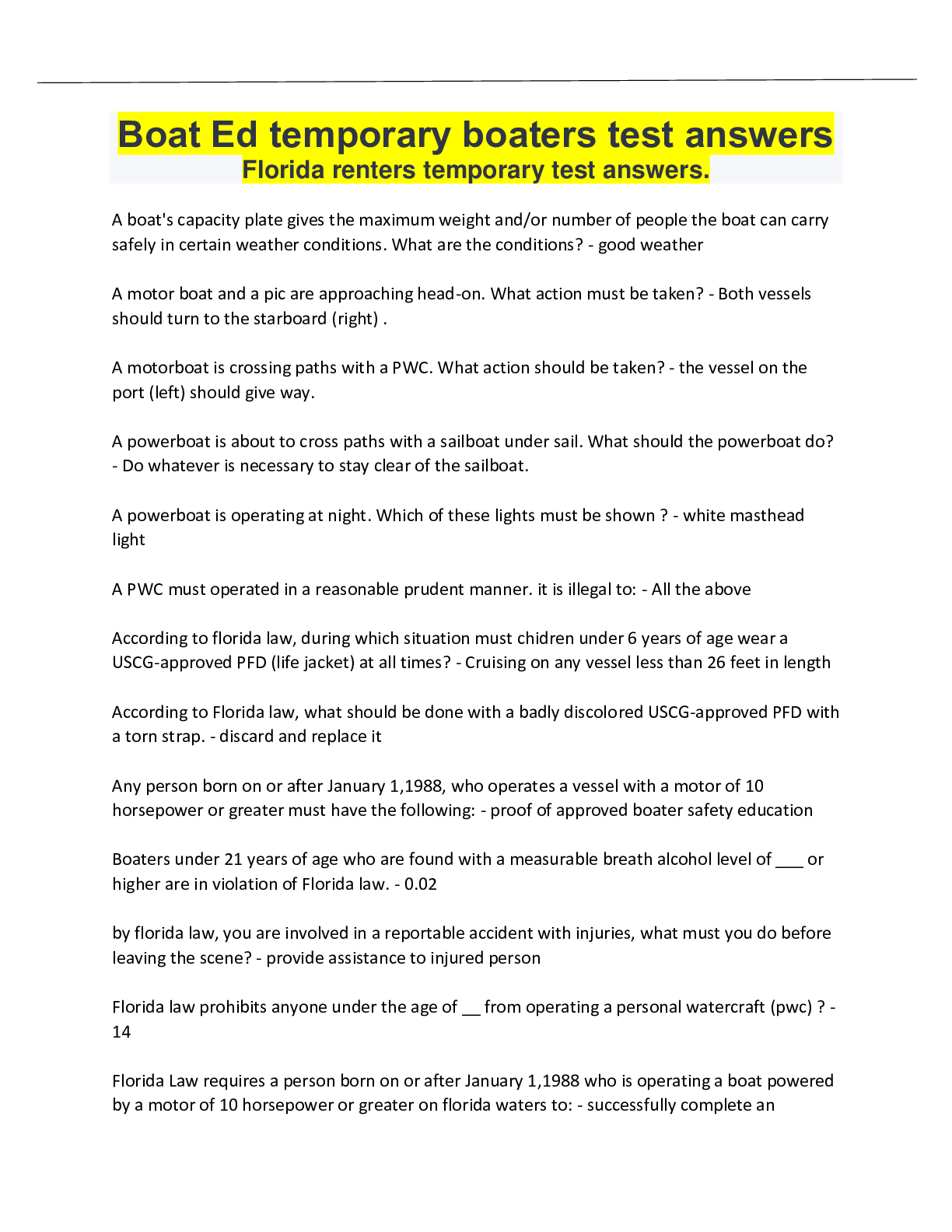
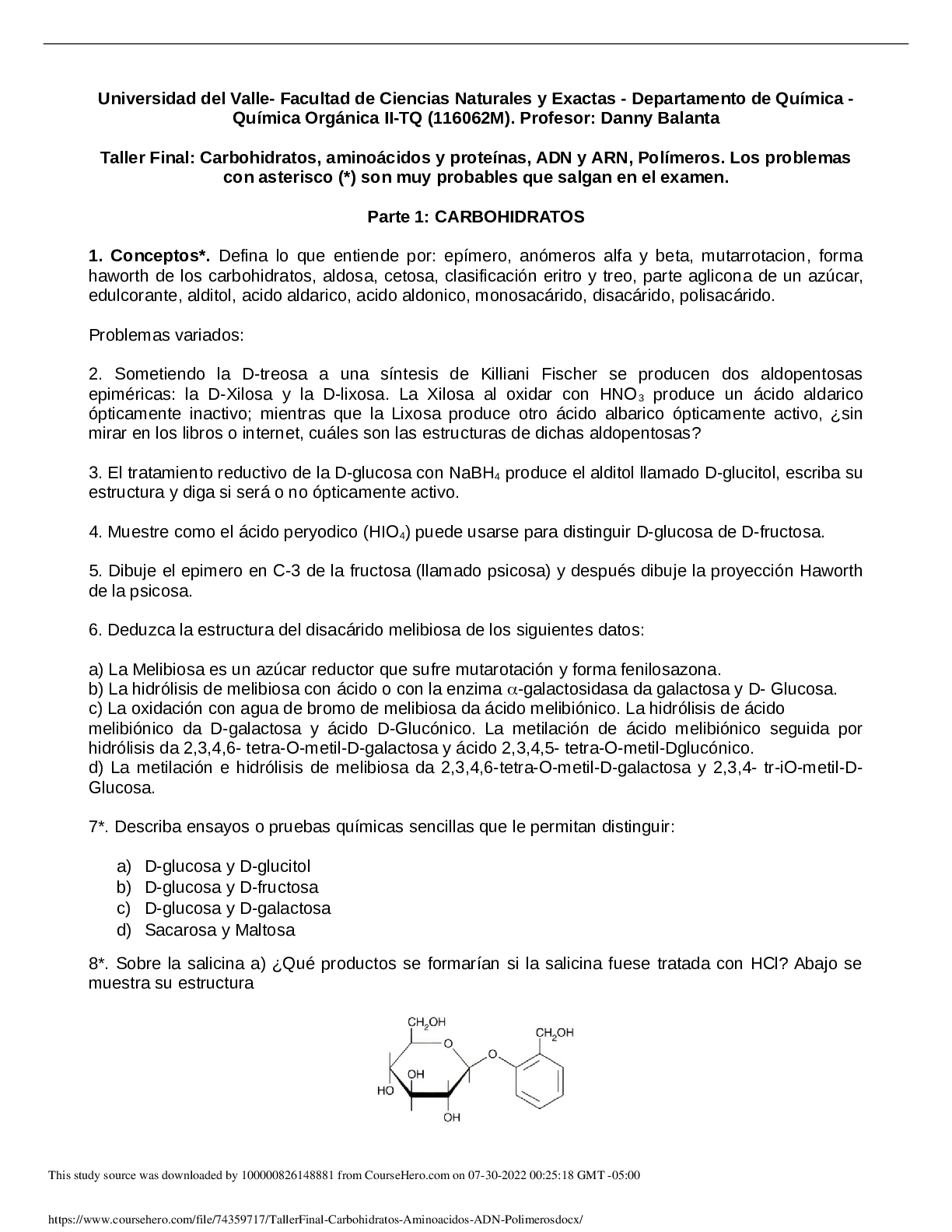
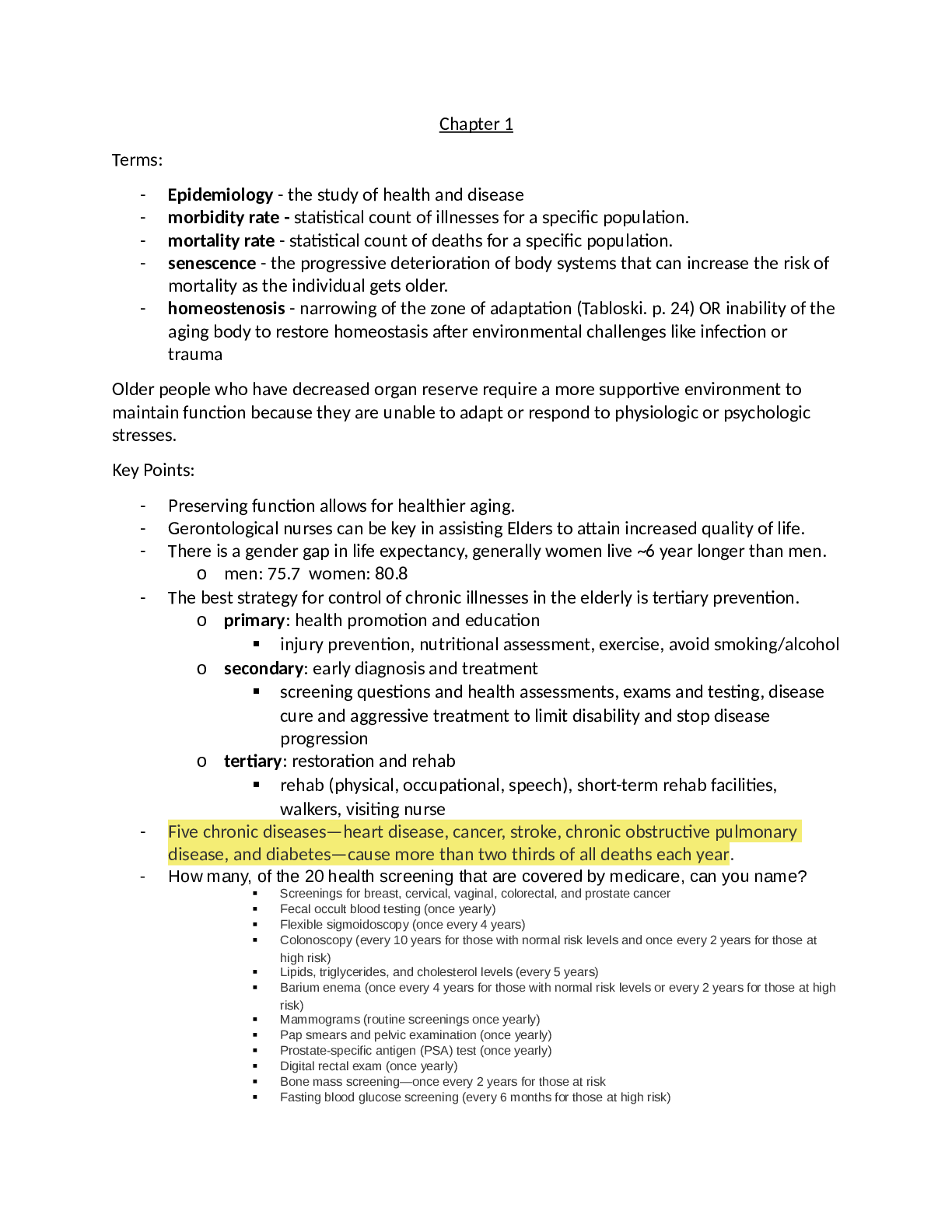

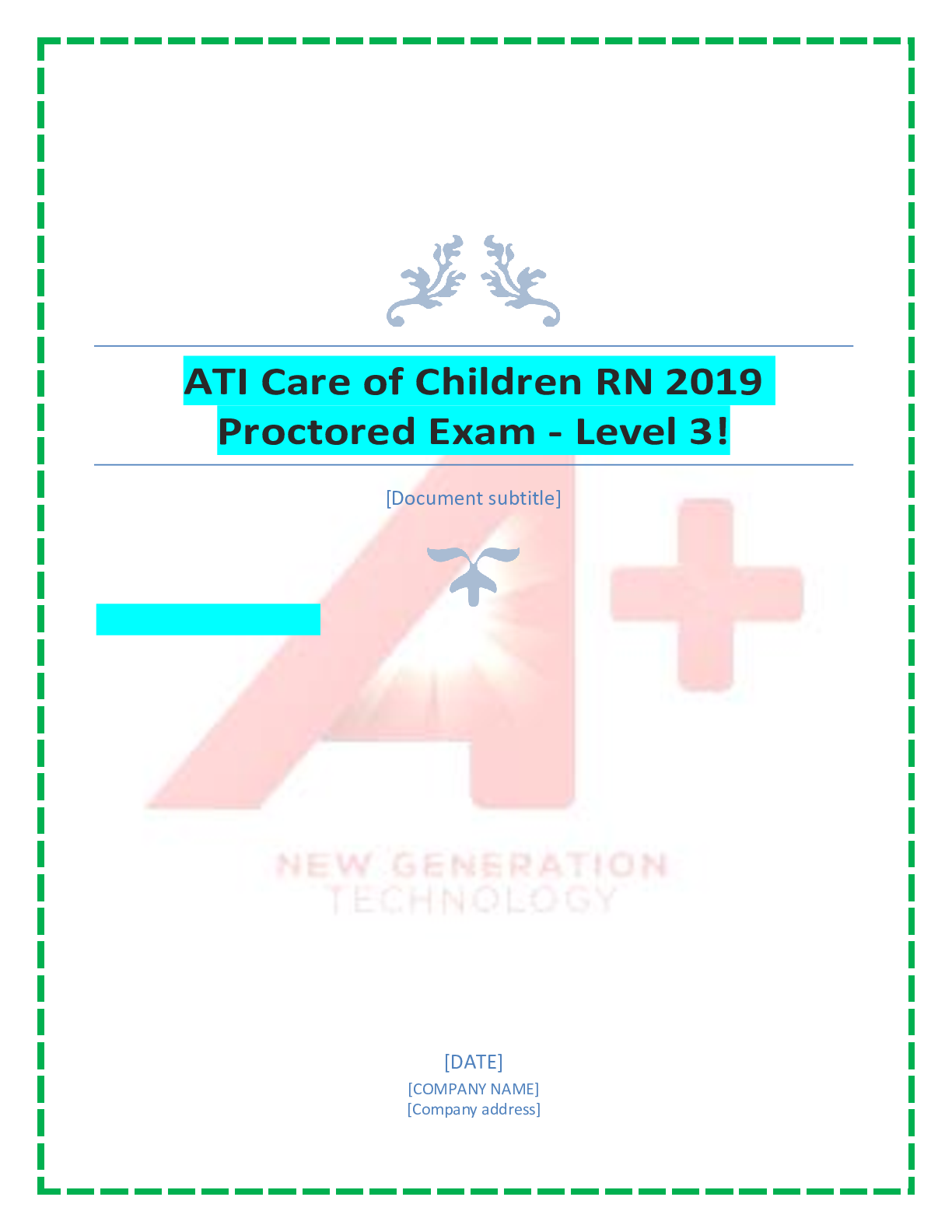
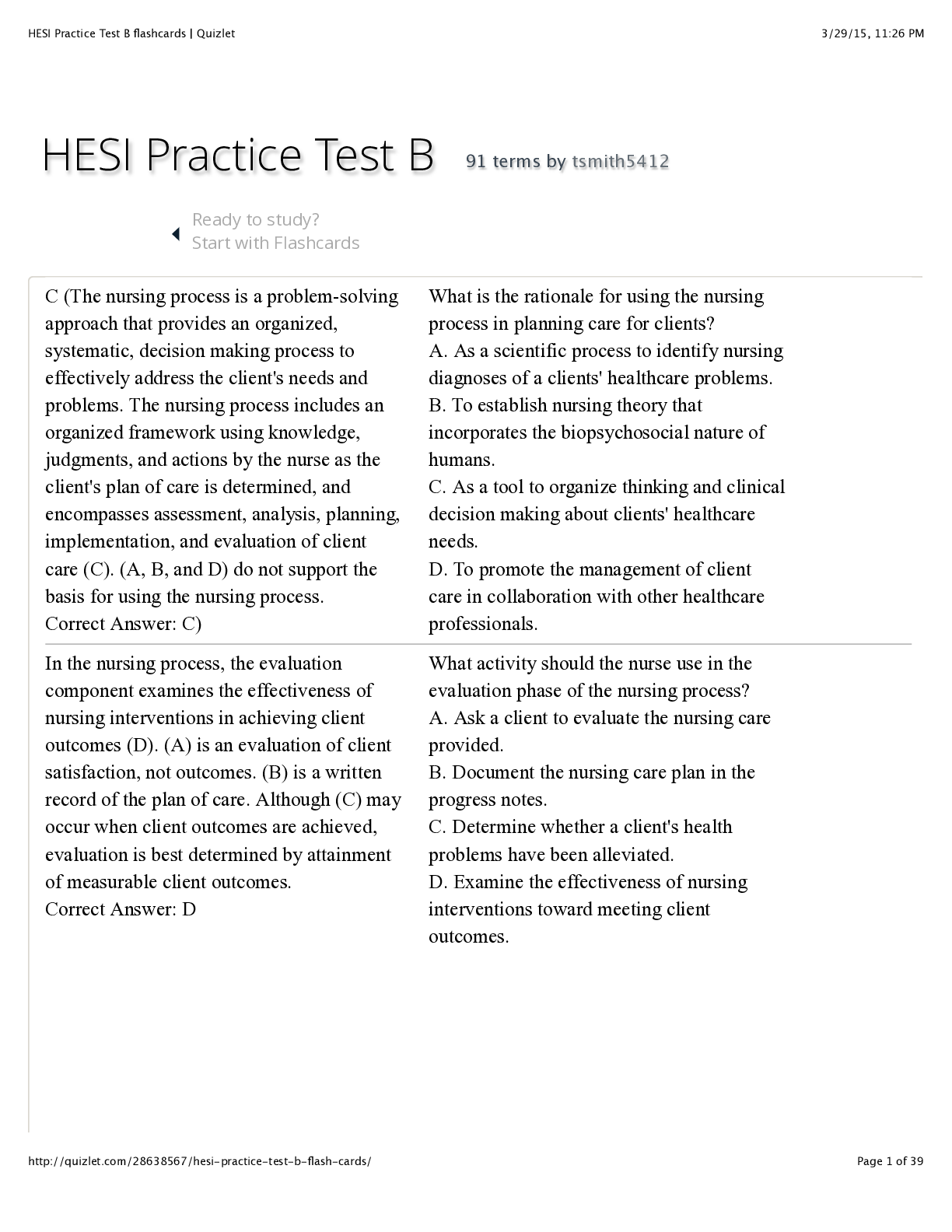
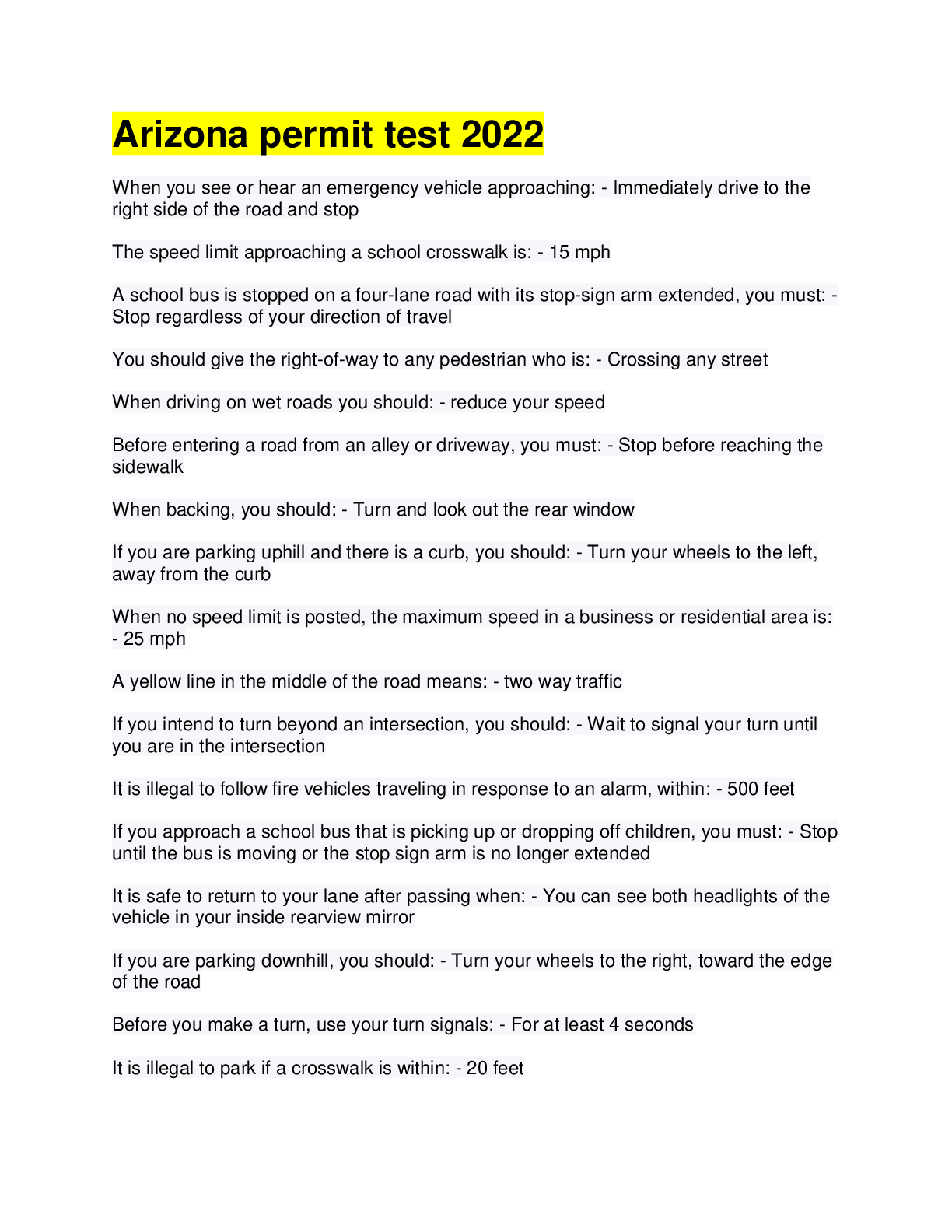


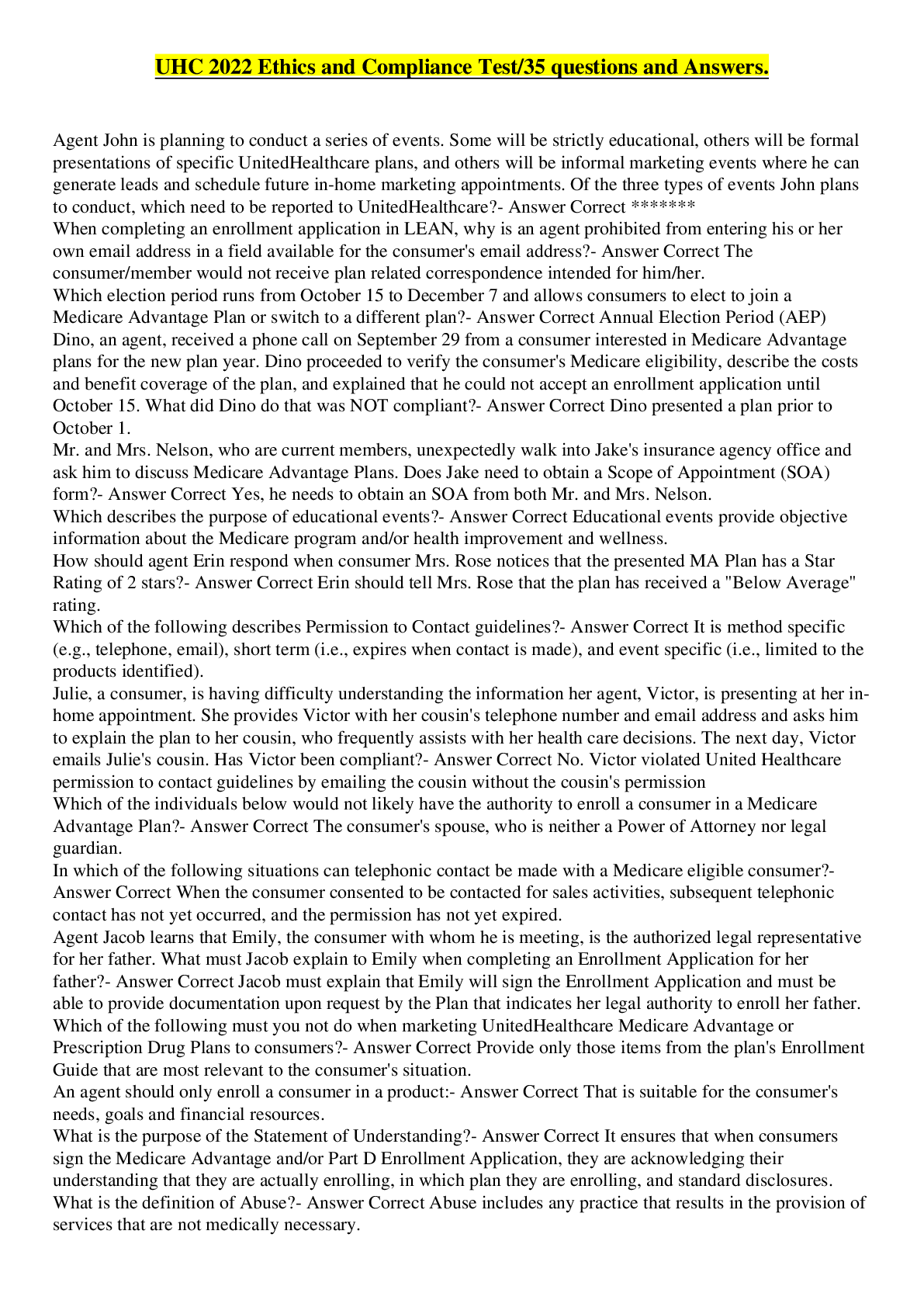
.png)
